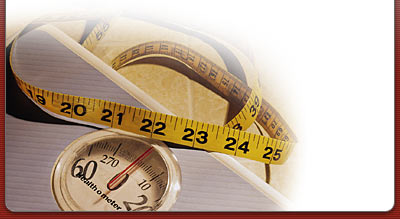 |
 |
|
|
| More than 60 percent of US adults
are overweight. Twenty five percent of US adults are also obese.
And, about 13 percent of US children are seriously overweight.
Take this true/false quiz with eight questions to see how much
you know about obesity. After each question, you will find out
if your answer is correct or incorrect, and information about
health risks and healthy choices will be provided. |
|
|
|
 |
|
 |
 |
|
|
|
An obese person has excess weight that includes muscle, bone,
fat, and water.
|
|
 |
|
 |
 |
|
|
|
Correct.
Actually, the term overweight includes muscle, bone, fat,
and water, but the term obese specifically refers to an excessive
amount of body fat. Some very muscular people may be considered
overweight without being obese.
|
|
|
|
 |
|
 |
 |
|
|
|
Incorrect.
Actually, the term overweight includes muscle, bone, fat,
and water, but the term obese specifically refers to an excessive
amount of body fat. Some very muscular people may be considered
overweight without being obese.
|
|
|
|
 |
|
 |
 |
|
|
|
A person becomes obese because he or she consumes more calories
than are burned off through activity.
|
|
 |
|
 |
 |
|
|
|
Correct.
Calories are stored as body fat when a person consumes more
calories than he or she burns off. The cause of calorie imbalance
differs from person to person. However, genetic, environmental,
psychological, and other factors are known to contribute to
obesity.
|
|
|
|
 |
|
 |
 |
|
|
|
Incorrect.
Calories are stored as body fat when a person consumes more
calories than he or she burns off. The cause of calorie imbalance
differs from person to person. However, genetic, environmental,
psychological, and other factors are known to contribute to
obesity.
|
|
|
|
 |
|
 |
 |
|
|
|
Obesity can be determined using key measurements including
the body mass index (BMI).
|
|
 |
|
 |
 |
|
|
|
Correct.
Body mass index (BMI) is used to measure the relationship
(or ratio) of a person's weight and height. A BMI is more
closely equated with body fat than other measures of height
and weight. A BMI of 25 to 29.9 is considered overweight;
a BMI over 30 is considered obese. Experts may measure waist
circumference to determine abdominal fat, and a waist-to-hip
ratio may also be calculated.
|
|
|
|
 |
|
 |
 |
|
|
|
Incorrect.
Body mass index (BMI) is used to measure the relationship
(or ratio) of a person's weight and height. A BMI is more
closely equated with body fat than other measures of height
and weight. A BMI of 25 to 29.9 is considered overweight;
a BMI over 30 is considered obese. Experts may measure waist
circumference to determine abdominal fat, and a waist-to-hip
ratio may also be calculated.
|
|
|
|
 |
|
|
|
 |
 |
|
|
|
Correct.
In addition to family history of certain chronic diseases
such as heart disease and diabetes, high blood pressure, high
cholesterol levels, or high blood sugar are all warning signs
of health problems that can occur with obesity.
|
|
|
|
 |
|
 |
 |
|
|
|
Incorrect.
In addition to family history of certain chronic diseases
such as heart disease and diabetes, high blood pressure, high
cholesterol levels, or high blood sugar are all warning signs
of health problems that can occur with obesity.
|
|
|
|
 |
|
 |
 |
|
|
|
Being overweight or obese increases the risk of developing
other health problems or diseases, such as cancer.
|
|
 |
|
 |
 |
|
|
|
Correct.
People that are obese are at increased health risk for many
diseases such as heart disease, type 2 diabetes, high blood
pressure, stroke, gall bladder disease, and osteoarthritis.
In women, obesity is associated with cancer of the uterus,
gallbladder, cervix, ovary, breast, and colon. In men, obesity
is linked to cancers of the colon, rectum, and prostate.
|
|
|
|
 |
|
 |
 |
|
|
|
Incorrect.
People that are obese are at increased health risk for many
diseases such as heart disease, type 2 diabetes, high blood
pressure, stroke, gall bladder disease, and osteoarthritis.
In women, obesity is associated with cancer of the uterus,
gallbladder, cervix, ovary, breast, and colon. In men, obesity
is linked to cancers of the colon, rectum, and prostate.
|
|
|
|
 |
|
 |
 |
|
|
|
A person must lose almost all of his or her excess body weight
to improve health problems that have occurred with obesity.
|
|
 |
|
 |
 |
|
|
|
Correct.
Actually, losing as little as 5 percent to 10 percent of
body weight can improve health problems linked to obesity,
such as high blood pressure and diabetes. The initial goal
for weight loss for overweight or obese people should be to
reduce body weight by about 10 percent from baseline.
|
|
|
|
 |
|
 |
 |
|
|
|
Incorrect.
Actually, losing as little as 5 percent to 10 percent of
body weight can improve health problems linked to obesity,
such as high blood pressure and diabetes. The initial goal
for weight loss for overweight or obese people should be to
reduce body weight by about 10 percent from baseline.
|
|
|
|
 |
|
 |
 |
|
|
|
A severely restricted diet is the best way to begin losing
weight.
|
|
 |
|
 |
 |
|
|
|
Correct.
A diet that severely restricts a person's food choices and/or
intake is not usually recommended. The healthiest way for
individuals to begin losing weight is to work with a registered
dietitian who can assess the type of diet needed for initial
weight loss. In addition, moderate levels of physical activity
for 30-45 minutes, 3 to 5 days a week should be part of a
comprehensive weight loss program.
|
|
|
|
 |
|
 |
 |
|
|
|
Incorrect.
A diet that severely restricts a person's food choices and/or
intake is not usually recommended. The healthiest way for
individuals to begin losing weight is to work with a registered
dietitian who can assess the type of diet needed for initial
weight loss. In addition, moderate levels of physical activity
for 30-45 minutes, 3 to 5 days a week should be part of a
comprehensive weight loss program.
|
|
|
|
 |
|
 |
 |
|
|
|
Incorporating healthy behaviors into your daily routine are
key to weight loss.
|
|
 |
|
 |
 |
|
|
|
Correct.
Experts say that your success with weight loss will depend
on your level of obesity, overall health condition, and motivation
to lose weight. Treatment may include a combination of diet,
exercise, behavior modification, and sometimes weight-loss
drugs. In some cases of severe obesity, gastrointestinal surgery
may be recommended.
|
|
|
|
 |
|
 |
 |
|
|
|
Incorrect.
Experts say that your success with weight loss will depend
on your level of obesity, overall health condition, and motivation
to lose weight. Treatment may include a combination of diet,
exercise, behavior modification, and sometimes weight-loss
drugs. In some cases of severe obesity, gastrointestinal surgery
may be recommended.
|
|
|
|
 |
|
|
|